The Okefenokee Swamp, located in south east Georgia, is 438,000 acres, the largest blackwater swamp in North America, the largest National Wildlife Refuge in the eastern U.S, and one of the only self-contained wetlands in the world that is naturally functioning. It is rich in biological diversity, and home to over 2,000 species of mammals, birds, reptiles, fish, and plants. Stephen C Foster State Park, located in the Okefenokee, is a certified dark sky park.
The Okefenokee Swamp is contained by Trail Ridge on it’s eastern side. This narrow geological formation (1-2 km wide) runs about 160km from Georgia into Florida. In several places along Trail Ridge, there are formations of heavy mineral sands (HMS). HMS are sources of various minerals, including titanium, in the form of titanium dioxide (TiO2).
Due to the presence of HMS, Trail Ridge is a target for mining operations and Trail Ridge, not near the Okefenokee swamp, has been / is being mined.
Twin Pines Mining Company has proposed to mine Trail Ridge near the Okefenokee Swamp. Environmentalists are concerned that mining along Trail Ridge will destroy habitat, release heavy metals into the surrounding water supply, create a fire hazard, and endanger the overall ecosystem. The mining company counters that they will create valuable jobs and not harm the swamp.
There are conflicting reports around the potential short-term and long-term environmental impact of the mine. Twin Pine’s scientists disagree with those from US Fish and Wildlife Service and many years of peer-reviewed research. Overall, the science community agrees that mining has great potential to harm the Okefenokee, and the science community in Georgia published an open letter about the extent of the temporary and permanent change to the Okefenokee.
Currently, the Twins Pines Proposal is being reviewed by the Georgia Environmental Protection Division. 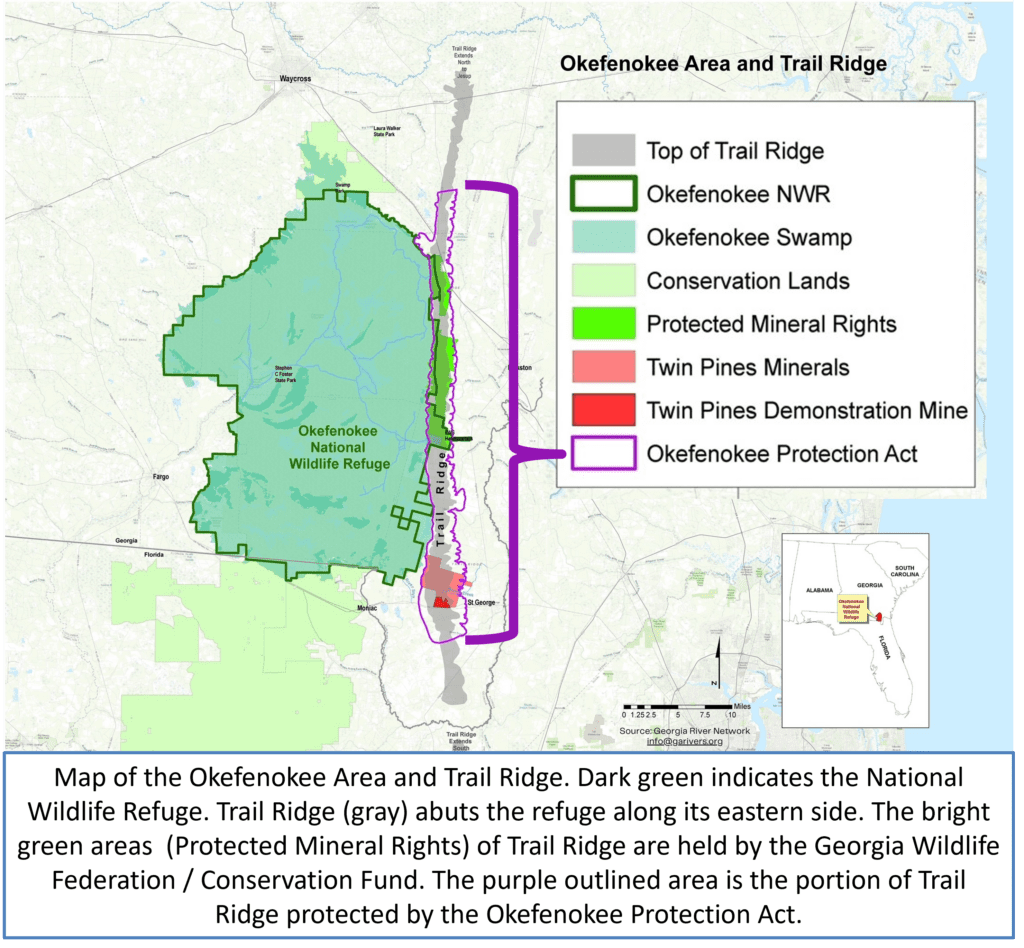
Possible Mining Impacts
Mining near the swamp has the potential to cause both environmental and economic harm.
Impact on the environment of the swamp
There are conflicting reports around the potential short-term and long-term environmental impact of the mine. Twin Pine’s scientists disagree with those from US Fish and Wildlife Service and many years of peer-reviewed research. The science community in Georgia published an open letter about the extent of the temporary and permanent change to the Okefenokee.
Mining along the trail ridge could compromise the habitat the swamp offers all species, including the endangered gopher tortoises, round-tailed muskrat, red-cockaded woodpeckers, wood storks, and eastern indigo snakes.
Digging up Trail Ridge and then replacing it post mining will mix the existing layered sands, clays, and organic matter. This makes Trail Ridge more porous and thus more conductive to water, lessening its ability to hold water. This will alter groundwater flows through Trail Ridge and possibly lead to permanently lower water levels in the Swamp, depending on the spatial extent of such modification. The leakage through the modified Trail Ridge means that water pumped by the mining activity will largely derive from the Okefenokee Swamp.
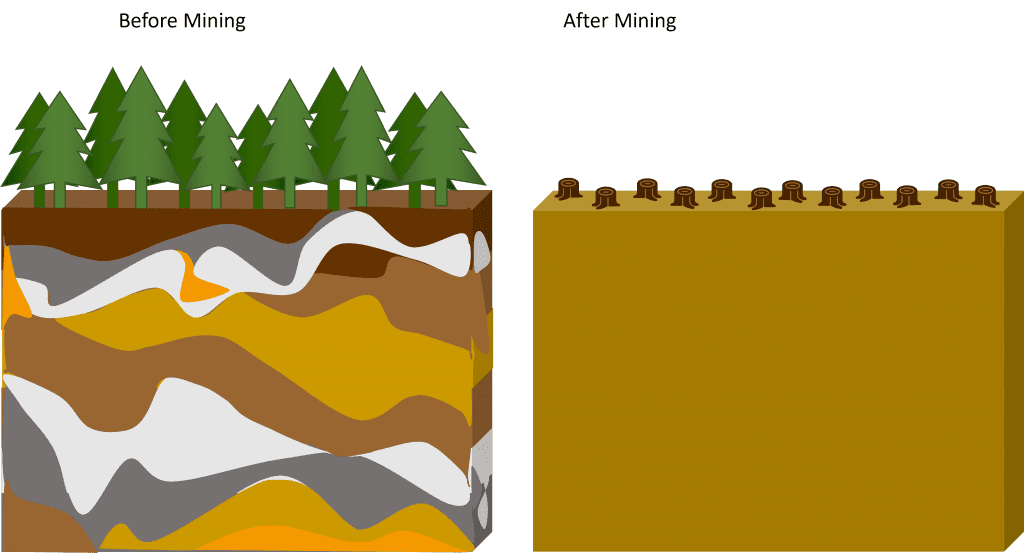
The mining permit proposes to pump 1.44 million of gallons per day (MGD) of groundwater, which is the approximately daily need of a town of 19,000 people. This is projected to cause the water table in the Floridan Aquifer underlying the swamp to lower by as much as 9 feet. One-year post-pumping, the aquifer under the swamp will still be 1.3 feet lower than pre-pumping levels. This aquifer drawdown will create a downward hydraulic gradient from the Swamp and will cause a drop in Swamp water levels as a result.
Lowered water levels cause the following environmental issues:
-
- Mining will impact the water quality of the Okefenokee Swamp and downstream rivers, including the St Mary’s and Suwannee Rivers, through release of stored chemicals, including toxic heavy metals.
- Mining will increase fire risk to both the swamp and nearby private property, including timber and blueberry farms.
- Mining will destroy the habitat of threatened and endangered species including gopher tortoises, indigo snakes, round-tailed muskrat, red-cockaded woodpecker, and possibly flatwoods salamanders, and habitat with the Swamp ecosystem.
Impact on the Economy of the swamp
Mining the Okefenokee Swamp threatens the economies of surrounding communities. The location of the mining operation in such proximity to the swamp will degrade the wilderness and dark sky experience, which are major draws for the 600,000+ annual visitors.
This will diminish the swamps economic benefit for Southeast Georgia, threatening the $17.2 million gained in employment, $5.4 million in total tax revenue for local counties, and $65 million in tourism.
Local cities of Homeland, Kingsland, St Mary’s, Waycross/Ware County, and Valdosta, have passed resolutions asking state officials to do everything possible to protect the Okefenokee and their communities’ livelihoods.
Overview of Conflicting Evidence
What does Twin Pines say?
At the request of the U.S. Army Corps of Engineers, Twin Pines produced an Impact Report on Jan 14, 2020. This report has less stringent guidelines then an Environmental Impact Statement (EIS) which is not required due to the size of the mine.
This report states that there will be minimal impact on the surrounding area and that any change to water levels will be minimal and temporary. Hydrology models were provided as evidence for these claims.
What did the US Fish and Wildlife Service Say?
The US Fish and Wildlife Service (USFWS) disagrees with the Twin Pines Impact Report.
In a letter to the U.S. Army Corps of Engineers, USFWS stated that, “…we have concerns that the proposed project may pose risks to the Okefenokee National Wildlife Refuge (OKENWR) and the natural environment due to location associated activities, and cumulative effects of similar projects in the area.”
Major issues cited in the letter include the erosion of Trail Ridge as the eastern barrier of the swamp, demonstration mining would be shallower than future mining and might not reflect full future impacts, and Twin Pines’ use of an outdated hydrogeology model.
Recommendations
It is important to note that this proposal is for a “demonstration mine” and that Twin Pines plans to continue mining after this initial ask. Given the complexity of the water system and geology in and around the Okefenokee Swamp, this plan cannot be viewed in isolation, but rather as the start of a larger operation.
Importantly, a majority of the established research supports the claims that mining close to the swamp has a high likelihood of causing permanent damage to the swamp and surrounding areas. Until the science proves otherwise, we are opposed to mining in the vicinity of the Okefenokee Swamp.
Learn more about how you can take action.
Okefenokee Science FAQ
As a National Wildlife Refuge with a unique ecosystem, the Okefenokee Swamp is on a list to be considered a UNESCO World Heritage Site. It is a unique ecosystem that provides economic opportunities for the State of Georgia, is home to a diverse group of animal and plant species, many of whom are endangered, and holds importance for Native American tribes who have worked or lived on the land for generations Image Source.
Image Source.
The Okefenokee Swamp is a swamp comprised of peat and wetlands mainly in Clinch, Ware, and Charlton counties in Georgia and Baker County in Florida. It is about 438,000 acres and protected mainly by the Okefenokee National Wildlife Refuge and Okefenokee Wilderness. It has been protected by the federal government since 1937, has been named a Wetland of International Importance, designated as a National Natural Landmark, and is listed as a tentative UNESCO World Heritage Site. The Suwanee River and the St Mary’s River originate in the swamp. The eastern border of the Okefenokee Swamp is Trail Ridge, a geological formation that acts as a dam for the swamp water.

Image source: Tim Ross.
Peatlands are a carbon and heavy metal sink. When they are destroyed, they release the stored carbon, and also accumulated mercury, lead, and other metals. If these metals are released in large quantities, they may flow via the water into neighboring rivers and water supplies, and end up being absorbed by fish, wildlife, and/or crops. Mercury, lead, and other heavy metals are hazardous to human health, even in small quantities.
Wetlands serve as flood control, wildlife nurseries, and water filters. They are important part of the ecosystem.
The swamp is home to 49 species of mammals, 233 species of birds, 64 species of reptiles, 39 species of fish, 37 species of amphibians, 1,000 moth species, and 600 plant species.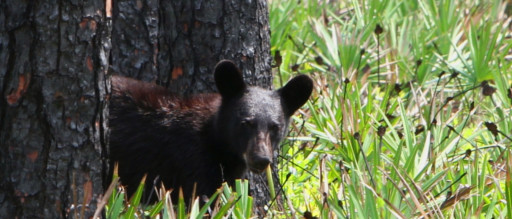 Image From US Fish and Wildlife
Image From US Fish and Wildlife
Endangered species that rely on the swamp include wood storks, eastern indigo snakes, and red-cockaded woodpeckers.
Trail Ridge, the eastern border of the Okefenokee Swamp is a narrow geological formation (1-2 km wide) that runs about 160km from Georgia into Florida. It is about 46-77m high, bordering the Okefenokee Swamp. In several places along Trail Ridge, there are formations of heavy mineral sands (HMS).
The below picture shows that HMS are stacked in layers like pancakes.
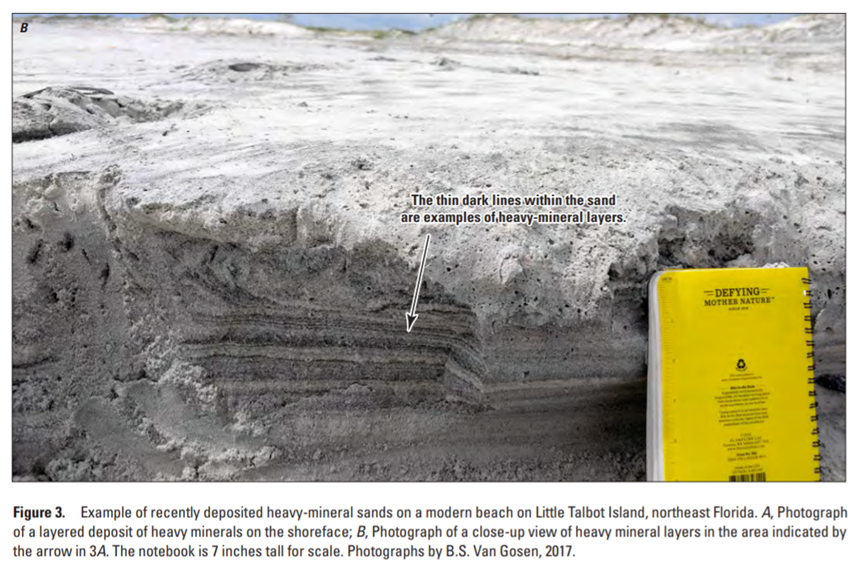 Photo and caption from https://pubs.usgs.gov/sir/2018/5045/sir20185045.pdf
Photo and caption from https://pubs.usgs.gov/sir/2018/5045/sir20185045.pdf
HMS are a source of Titanium. Titanium is a component in aerospace and defense applications; however, over 95% of domestic consumption is for titanium dioxide, a pigment used in consumer products, mainly paint.
Twin Pines has purchased 12,000 acres along Trail Ridge.
1st Proposal
Total Acres – 2414
Acres to Mine – 1300
Maximum Depth – 70ft
Acres mines per month – 25-40
2nd Proposal
Total Acres – 1042
Acres to Mine – 898
Maximum Depth – 25-50ft
Acres per month – 8
On the surface of Trail Ridge, if water falls on the east side of the ridge it flows to the east, and if it falls on the west side of the ridge it flows to the west. Twin Pines produced an Impact Report on Jan 14, 2020 that states that Trail Ridge is not a “dam” for the Okefenokee Swamp, but rather a hydraulic barrier to groundwater. This means that underground, the water flows just like it would above ground: east goes east, and west goes west. The below picture on the left shows this theory.
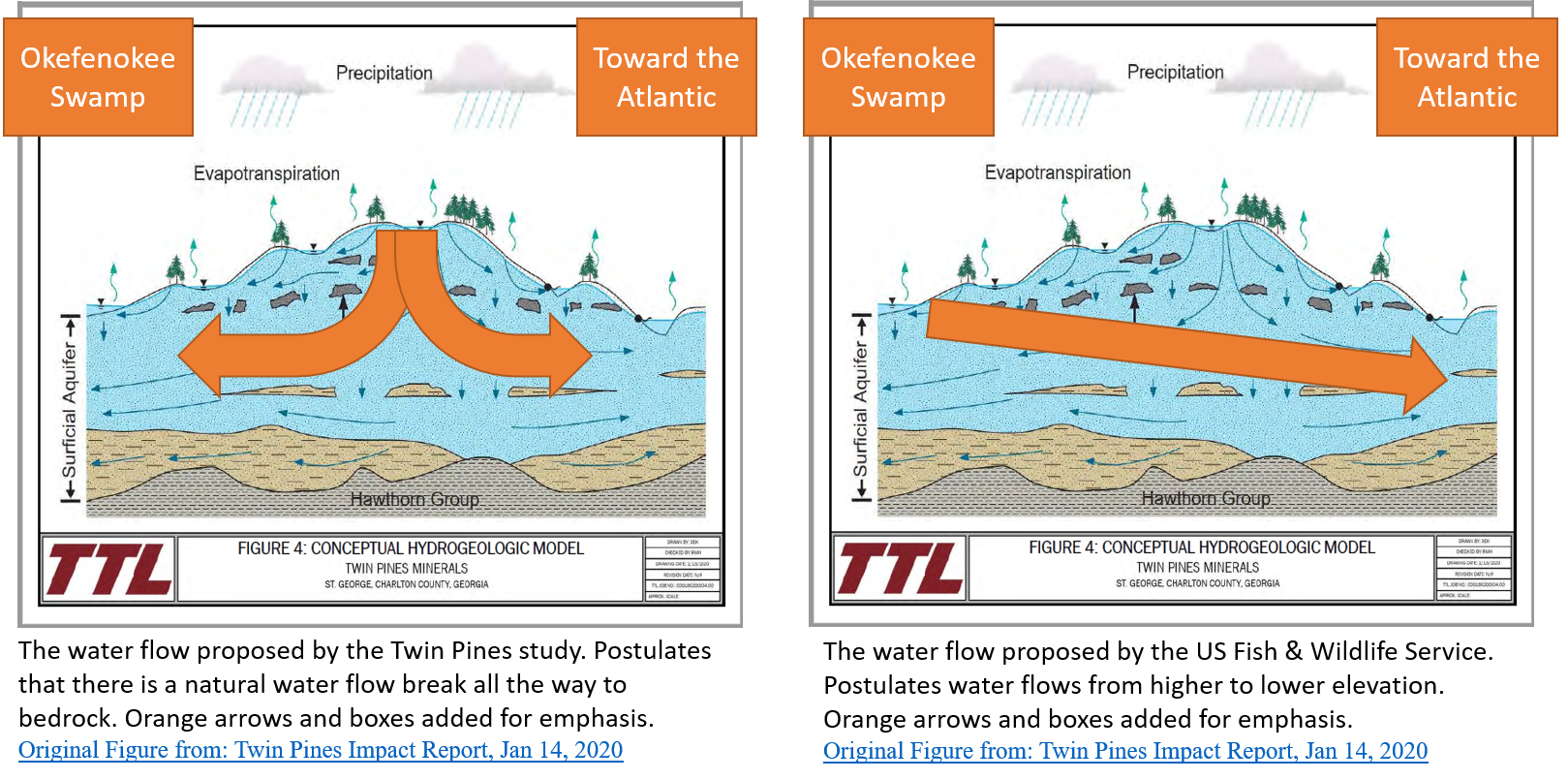
If this is the case, mining of Trial Ridge would not destroy a barrier that creates the swamp and have only minimal impact or no impact on the water level in the Okefenokee Swamp.
The USFWS disagrees with this assessment. The evidence submitted to support this claim is not adequate and it has not been confirmed and/or peer-reviewed by other scientists. USFWS instead believes that if Trail Ridge is changed, water will flow out from the swamp in the west, and into the lower lying land in the east. The above picture on the right shows this theory.
A more recent study.

Not necessarily. Trail Ridge is made of layers (see images in “What is Trail Ridge?”). When the ridge is backfilled, the resulting formation will no longer be layered, and no one knows what that will do to the structural integrity of formation. As mining is expected to go below the water table level, it may have a permanent impact on the Okefenokee’s ability to maintain its water level.
The Twin Pine’s claim of temporary impact has not been validated or peer reviewed, and several studies indicate that the changes may cause the ecosystem to be unable to recover or sustain itself.
A study on the impact of oil sands mining in Alberta, Canada showed a significant release of carbon, and demonstrated over 50% permanent wetland loss. While Canada is a long way from Georgia, this study does indicate that there would be a release of stored carbon (which would happen immediately) and that restoring an ecosystem is a complex process.
Heavy metal mining projects result in the creation of by-products that contain heavy metals and can affect the quality of groundwater, compromising its safety for human consumption and negatively impacting local ecosystems.
According to a 30-year-career hydrologist, the impact report Twin Pines produced was missing several key pieces of information relating to the disposal of heavy-metal byproducts, withdrawing water from the Upper Floridian Aquifer, and induced recharge to shallow aquifers.
Twin Pines has not included contaminant transport or disposal information in their hydrogeology model. Twin Pines’ impact report includes scant detail about the properties of the Hawthorn Group, a ground layer the protects and confines water to the Upper Floridian aquifer. Mining could erode this protective layer and cause detrimental leakage of water from the aquifer. Twin Pines also failed to address the impact that induced, artificial recharging of an aquifer instead of natural recharge via precipitation would have on the OKE Swamp.
Additionally, around 22,000 comments were submitted to the EPD, voicing concern over the mine in response to the pending permit.
The Okefenokee provides contributions to the local economies via recreation and tourism.
The Okefenokee National Wildlife Refuge entertains approximately 600,000 visitors each year, bringing business to the surrounding towns of St. Marys, Woodbine, and Kingsland. Non-residents account for $59.8 million of the total $64.7 million in recreational expenditures accrued by the four surrounding counties. The Okefenokee has created around 753 jobs, generating $17.2 million in employment income and $5.4 million worth of tax revenue.
The proposed mine is of heavy mineral sands (HMS) which are found throughout the Atlantic Coastal Plain.
According to the US Geological Survey:
“Ancient and modern coastal deposits of heavy-mineral sands (HMS) are sources of several “heavy” industrial minerals with mining and processing operations on many coastal regions worldwide (Van Gosen and others, 2014). For example, HMS deposits are a significant source of titanium feedstock for the titanium dioxide (TiO2) pigments industry. The titanium feedstock is extracted from the minerals ilmenite (Fe2+TiO3), rutile (TiO2), and leucoxene (an alteration product of ilmenite).”
Of particular interest is the titanium dioxide contained in the HMS. Approximately 95 percent of the U.S. consumption of titanium is used to produce Titanium Dioxide (TiO2) pigment. US production of TiO2 pigment in 2022 was an estimated 1.1 million tons. The US is a net exporter of titanium dioxide pigments.
Titanium is a component in aerospace and defense applications; however, “Approximately 95% of titanium is consumed in the form of titanium dioxide (TiO2), a white pigment in paints, paper, and plastics.”
A working group concluded that domestic titanium production is not vital for national security purposes.
Titanium is an element. “It is the ninth most abundant element on the Earth’s crust.” But that is not the whole story.
Most of titanium is found naturally in the form of ilmenite – an iron titanium oxide. To get titanium and titanium dioxide, the mined ilmenite needs to be refined. This ilmenite and other compounds are what will be mined from Trail Ridge.
Titanium is a strong metal that is used in jewelry, sports equipment, surgical implants, and aircraft.
Titanium dioxide is a white pigment that is used to paints, paper, plastics, and as a food additive.
“Approximately 95% of titanium is consumed in the form of titanium dioxide (TiO2).”
No.
Titanium is the ninth most abundant element in Earth’s crust. (Rudnick and Fountain, 1995). Titanium can be found in nearly all rocks and sediments, and thus, unlike many other elements of economic interest, it is considered to be a major element rather than a trace element.
No.
A working group concluded that domestic titanium production is not vital for national security purposes.
US production of titanium dioxide (TiO2) pigment in 2022 was an estimated 1.1 million tons. The US was a net exporter of TiO2 pigments.
There is only one active titanium refinery in the US, located in Utah. The others were shuttered due to economic forces. A majority of titanium used in the US is imported, with 89% of imports coming from Japan.
Titanium is currently not critical for EVs.
As quoted in https://climate.mit.edu/ask-mit/there-enough-titanium-support-growth-electric-vehicle-production-us:
“Titanium is considered a critical mineral by the US Geological Society, but not because of its use in vehicles. Most titanium—about 95%—is made into titanium dioxide, a pigment that keeps anything from paints to plastics white.”
“When it comes to vehicle production, there’s a strong market for titanium, but demands aren’t nearly as high as they are for other metals used in EV production, like cobalt and lithium, which are expected to have a 37-fold and 18-fold increase in demand, respectively, by 2030.3 One 2020 study evaluated supply risk for 52 mineral commodities that are critical to the US manufacturing sector and found that supply risk for titanium is fairly low, but economic vulnerability—which is a consequence of supply disruption—is much higher.”
“… that supply risk can also be ameliorated by recycling potential…it can be recycled over and over again, and there’s an economic incentive to do so, as recycling is cheaper and less dangerous than mining new material. More than 90% of titanium used in the United States is recycled.”
What about batteries?
Titanium dioxide (TiO2) and titanium niobium oxide (TNO) are being explored to replace graphite in the anode material in Lithium-Ion Batteries (LIBs). “In the past 40 years, more than 1000 studies about anatase TiO2 electrodes for rechargeable ion batteries have been reported.” Progress has been made on providing a viable commercial alternative – but thus far – all of this technology is still in development and not ready for commercial use.
Read More
Open Letter from the Science Community about Proposed Mining Near the Okefenokee Swamp
Watch a Documentary about the Okefenokee Swamp
Watch a ST&T about the Okefenokee Swamp
Read what a 10 year old had to say about the proposed mine
NOTE: this article was updated on Jan 16, 2025 to reflect updates to the legal situation and known science.
Videos
Seminar on Understanding the Floridan Aquifer
Ogeechee Riverkeeper hosted an informational webinar on aquifers, groundwater and sustainability with James Reichard, Ph.D., professor of geology at Georgia Southern University (Statesboro). Attendees were also able to ask questions.
